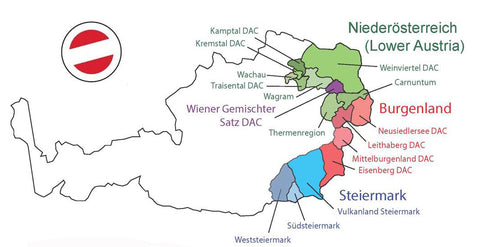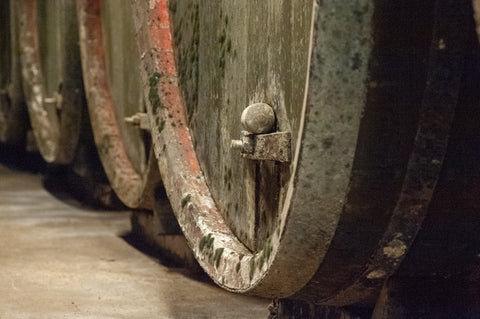Red Grape Varieties in Austria

Pinot Noir Grapes at harvest
Not only does Austria produce magnificent white wines, but the country also crafts exceptional red wines, offering an exciting glimpse into the country's viticultural future. These are reds that capture a palpable energy, boasting bright acidity, lither textures, and perfumed, fruit-driven aromatics.
And while some of these Austrian grape varieties may seem unfamiliar to our vernacular, we can assure you, the versatility in terms of food and wine pairings offers a dynamic alternative in our wine collection.
Where is red wine produced in Austria?

Map courtesy of Austrian Wine Marketing Board
Austria is comprised of four generic 'wine states,' or larger regions, Niederösterreich, Burgenland, Steiermark, and Wien, and within those areas, there are eighteen specified wine growing regions.

Map Courtesy of Austrian Wine Marketing Board
Since we're on the subject of red wine, let's talk about where it is primarily grown. Nestled along the Hungarian/Slovak border lies the Burgenland, comprised of 13,100 hectares under vine. This region is the largest producer of high quality red wines in the country, thanks to the formidable climate and warm Pannonian winds coming in from the east.
According to Austrian Wine, Burgenland was formed out of the Styrian and Pannonian Basins, as well as from the Eastern Alpine unit and the Penninicum. This geological formation resulted in varied subsoils and bedrocks, including sedimentary deposits, coarsely grained sandy gravels, dolomite and limestone. Specific DAC's within the Burgenland that are known for their high caliber red wines include Mittelburgenland, Rosalia, Eisenberg, and Leithaburg.

Thermenregion map courtesy of Austrian Wine Marketing Board
In addition to the Burgenland, the Thermenregion is also heralded for their exceptional red wines. Bordering the Burgenland region, the Thermenregion mainly works with local grape varieties like Sankt Laurent, Zweigelt, and Blaufränkisch, as well as French cultivars, like Pinot Noir, Merlot, and Cabernet Sauvignon.

For this blog post, I am going to touch on three important grape varieties, Zweigelt, Blaufränkisch, and Sankt Laurent, to paint a picture of the enormous spectrum of red wine produced in Austria.
Zweigelt

Zweigelt grapes at Weingut Dürnberg
Named after the plant breeder, Dr. Fritz Zweigelt, this grape variety is 100% Austrian, and is the most commonly planted red grape variety in the country.
The grape itself is a crossing of Sankt Laurent and Blaufränkisch, and was developed in 1922 in a laboratory at the Teaching and Research Centre for Viticulture and Horticulture at the Klosterneuburg wine research department.
According to current statistics provided by Austrian Wine, Zweigelt plantings span the majority of Austrian wine growing regions, accounting for approximately 6,230 hectares under vine (13.9% plantings). Due to the grape’s inherent inclination to ripen mid-harvest, Zweigelt can be picked earlier than the other red grape varieties, an advantage when working in unpredictable, northerly growing climates.
Zweigelt is fairly high yielding, yet with the 20th century shift towards quality over quantity, the wines are trending towards a fuller bodied, richer texture, with a distinctive tart, sour cherry note backed by delicate tones of cocoa and cracked black pepper.
The versatility of Zweigelt is endless, thanks to its flexibility in the cellar. Zweigelt wines can be matured in steel or in oak, the former maintaining a crisper, high toned acidity, while the latter developing a richer, bolder style. Both are equally fascinating, and Zweigelt is often used as a blending partner to other varieties because of its natural acidity and freshness.
When matured in barrique, the wines gain structure, spice, and length, and can be quite remarkable, particularly from the warmer growing regions, like Burgenland, Carnuntum, and the Thermenregion. These are red fruited gems, and pair effortlessly with our artisanal pizza here at Time Market.
Blaufränkisch

Blaufränkisch grapes on the vine
Blaufränkisch has played an enormous role in Austrian viticulture over the centuries. Taking the name Blau (Blue) Fränkisch (Franconia), the grape is of superior heritage, having been widely planted during the Habsburg Empire.
Today, the grape is grown throughout central Europe, where it is referred to by a plethora of synonyms, including Frankovka (Czech Republic), Kékfrankos (Hungary), and Lemberger (Germany/United States.)
While this variety does not necessarily produce wines of intense concentration and extract, like Cabernet Sauvignon wines out of Napa, Blaufränkisch remains at its core an exciting, peppery wine, with notes of dark plums and black cherries, and remains the second most dominant red grape variety under vine in Austria.
Blaufränkisch is a late ripening grape, meaning that the vines begin to sprout flowers later in the season. Due to this factor, frost is a constant risk in the vineyards, particularly in the cooler wine producing regions. Additionally, due to the grape's susceptibility for coulure in cooler growing seasons, Blaufränkisch can be quite challenging to grow successfully, leaving the optimal positioning in warm, sunny, south facing parcels.

Blaufränkisch macerating on skins in an open-top vat
In terms of vinification, cold soak, pre-ferment, open vat macerations are a common winemaking practice, allowing the polyphenols and tannins from the grape skins to boost the wine’s concentration, color, and fruit character.
Currently, there are nearly 2,600 hectares planted to Blaufränkisch, with the majority of plantings in the southeastern regions of Austria, including Burgenland, Thermenregion, Carnuntum, and Mittelburgenland. The warm Pannonian winds coming in from Hungary allow for the vineyards to remain dry and breezy, two vital factors that ensure the ripening of this rather demanding variety.
Due to Blaufränkisch’s high-yielding tendency (sometimes at 100 hl/ha), the larger production bulk wines of the late 20th century had a reputation for producing thinner, more astringent, lean wines.
Yet today, thanks to the ambition and vision of producers in the eastern half of the country, this is no longer the case, with producers like Johannesof Reinisch, Dorli Muhr, Umathum, and Weingut Moric, leading the pack on quality. These wines can be utterly fascinating, with depth, dark fruited notes, peppery spice, and firmly structured tannins, making them the ideal pairing to a tender filet, roast duck, grilled lamb skewers, or beef dumplings.
Sankt Laurent

Taking its name from St. Lawrence Day, the day when the Sankt Laurent grapes begin to ripen, this grape is native to Central Europe and spans just 621 hectares under vine, comprising just 1.4% of total Austrian vineyard plantings.
While this variety can produce silky, ethereal red wines, the grape is tremendously difficult to cultivate, as it is susceptible to fungus, mildew, and is sensitive to late frosts, producing unpredictable yields. Additionally, the grape is also susceptible to early flowering, a tremendous danger when speaking of spring frosts, an all too common occurrence in Austria.

All that being said, Sankt Laurent wines can be transformative, particularly those matured in barrique and grown in the southerly wine producing regions. These wines exhibit deeply hued tones of magenta/ruby, boasting notes of morello cherries, cocoa, and baking spice.
These are never opulent wines that garner high alcohol or extract, but instead demonstrate a tense, nervy acidity layered on top of a medium bodied mouthfeel, often finishing with fine grained tannins.

Meinklang Roter Mulatschak : Sankt Laurent/Zweigelt cuvée
Interestingly, we are seeing more Sankt Laurent produced as Pét-Nat, or Pétillant Naturel styles, like in the above photo of Meinklang's Roter Mulatschak. These wines capture the grape's signature high acidity and freshness, offering a delicious, lower alcohol option. This trending shift towards a minimal intervention, brighter style is catapulting the success of Sankt Laurent internationally.

